

Self-recognition in Communication across Time and Space
On the 9th Chinese Art Forum of Mainland, Hong Kong, Macao and Taiwan
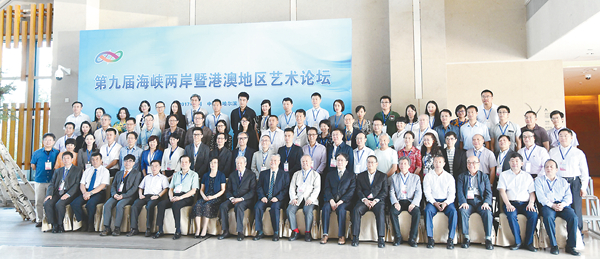
Group Photo of Distinguished Guests and Experts
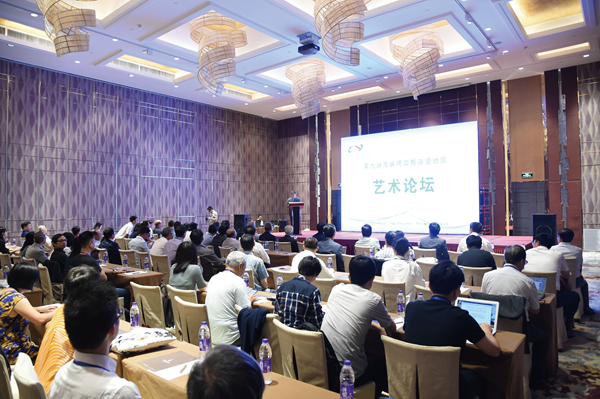
Scene of the Forum
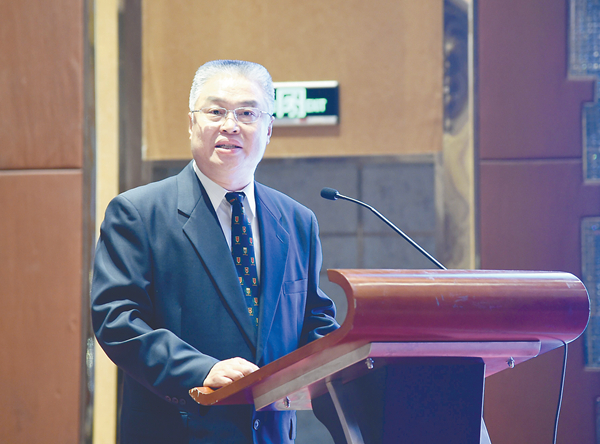
Guo Yunde delivered speech
From August 22 till 24, the 9th Chinese Art Forum of Mainland, Hong Kong, Macao and Taiwan was held at Harbin. Jointly sponsored by CFLAC, China Literary and Art Critics Association (CLACA) and Heilongjiang Federation of Literary and Art Circles (HFLAC), this Forum, under the theme of “Literary and Art Criticism and Innovative Development of Chinese Literature and Arts”, involves various art disciplines such as literature, theatre, music, fine arts, Quyi, dance, folk arts, calligraphy, acrobatics and TV art. Focusing on such themes as the relationship of literary and art criticism with cultural standing, Chinese cultural tradition, dissemination and rejuvenation, and online literary and art development, experts and scholars from Mainland, Hong Kong, Macao and Taiwan gathered to share their viewpoints through keynote speeches and group discussion so as to make their own contribution to the prosperity of contemporary Chinese culture and arts.
Distinguished guests such as GUO Yunde and CHEN Zhenlian, vice presidents of CFLAC, LIU Guosong and SHI Ziqing, honorary member of the 10th National Committee of CFLAC, WU Zhiliang, president of Macao Foundation, Tian Wenyuan, deputy director general of Publicity Department of Heilongjiang CPC Committee, FU Daobin, president of HFLAC and ZHU Ting, deputy director general of Publicity and Culture Department of Central Liaison Office in Hong Kong attended the opening ceremony and other events, along with the representatives from CFLAC, Ministry of Culture, Central Liaison Offices in Hong Kong and Macao as well as over 80 well-known experts, scholars, critics and artists.
GUO Yunde delivered a speech at the opening ceremony. As he expressed, in the respect of strengthening communication and coordination in literature and arts across the Straits and between Mainland, Hong Kong and Macao, exploring development principle of Chinese literature and arts, enhancing national pride and self-confidence in culture and promoting Chinese arts into the world arena, this Forum has played a positive role and exerted a beneficial impact. This Forum has become not only an academic platform to exchange artistic creation experience and deepen theoretic research and criticism among experts from different localities of China, but also an important bond to achieve friendship, consensus and common vision. In the context of globalization and in face of new challenges, how to elaborate, revitalize and inherit the traditional Chinese culture, and promote the innovative development of Chinese culture and arts, just as the theme of this Forum indicates, has become a hot issue as well as a pioneering topic in the development course of academic research in culture as well as literary and art criticism.
As GUO Yunde stressed, Chinese nation is heading for a great revival and sufficient efforts must be made in the following two fronts so as to ensure the prosperity of Chinese culture. First of all, history must be retrieved to provide a profound elaboration of historical origin, development sequence and tendency, unique creation, values concepts and distinct characters of Chinese culture, to hold fast to the fundamental standing and gene of Chinese culture, and to bring the values of guidance of Chinese culture into full play. On the other hand, the current reality is the very starting point. More nutrition must be absorbed from the traditional treasure of culture and in combination of social practice and times requirement, then conveyed in a universal way. Those cultural creations in times fashion must be realized so as to come up with some milestone Chinese cultural products with in-depth historical connotation, contemporary Chinese expressions, common concerns and aesthetic of humankinds manifestation and significant positions in the global cultural arena.
As TIAN Wenyuan mentioned in her speech, this Forum has established a new platform for cultural and art exchange between Mainland, Hong Kong, Macao and Taiwan as well as broadened vision and provided opportunities for literary and art workers and their cause in Heilongjiang Province. Exchange and mutual reference, as a key motivation for human progress as well as world peace and development, lead to the colorful brilliance of human civilization. As a golden key to open heart and mind, cultural exchange will bring people of different cultural backgrounds and ideologies into mutual understanding and appreciation. More achievement is expected from this Forum so as to facilitate a rapid development of Chinese literary and art criticism cause, and promote the prosperity of Chinese culture.
At this Forum, FU Daobin, MAO Junhui, ZHU Shoutong, JIANG Shuzhuo, WANG Weijiang, SONG Shenggui and ZHANG Zhiqing shared with each other their research achievement on the following topics: “Thinking Principle of Literary Criticism”, “Starting Elaboration from the Traditional-World Performing Arts”, “Relationship of Literary Criticism Subjects and Critical Essay Types”, “Expected Dialogue of Contemporary Literary and Art Criticism and Cultural Tradition”, “The Role of TV Programs in the Relationship across the Straits”, “Contemporary Art Criticism in China: Self-Awareness of Cultural Resources of Minority Nationality to Be Enhanced” and “Cultural Inheritance and National Image Establishment”.
On August 23, such experts as WANG Yonghao, LIU Guosong, YANG Chuntang, ZHANG Zexun, JIN Hao, YU Wenxiu, ZHONG Mingde and LU Weili respectively conducted an in-depth exchanges concerning the following topics: “Necessity of Criticism of Chinese Style”, “Renaissance of Chinese Ink and Brush Art”, “White Porcelain Box and Museum”, “Cultural Exchange across Time and Space—Colorful Sculpture Art of Guizi Grotto at Ancient Silk Road”, “Contemporary Aesthetic Appreciation of Chinese Classical Dance”, “Literary Survival in Material Age—Creation Theory of Women Writers Born in the 1970s and 1980s”, “From Artistry to Body Theatre: TAO Ye Provides for Discussion of ‘Verticality’” and “The Question of Chinese Schools in Theatre Analysis”.
On August 24, starting from their familiar domains and their pride in Chinese culture ,and in full expectation for Chinese cultural and art rejuvenation, all the participants realized serious observations and discussions about the innovative development of literary and art criticism and Chinese culture from the global perspective, and conveyed their profound love and persistent pursuit of traditional Chinese culture and arts. As ZHOU Youqiang, deputy director general of Literary and Art Criticism Center of CFLAC summarized, concerning the main theme, plenty of consensuses have been achieved so as to lay a sound foundation of fraternity for the ongoing discussion of Chinese cultural and art development, which is absolutely the most important outcome of this Forum. In a word, we all need to find self-recognition through communication across time and space.

FU Daobin (President of Heilongjiang Federation of Literary and Art Circles)
Currently great changes have taken place in the outlook of academic research. Digital measures represented by computer technology have entered our academic research as a solution for textual criticism and concrete evidence, and thus standard technology, strict procedure of argument and accuracy in data input are more stressed. Though there is a certain reasonable ground, such measures should never provide for ignorance of our thinking. Some scholars, though keen on collecting materials, are hardly concerned with theoretical judgment. As a matter of fact, the true academic research is more of thinking and theory than of technology. Without the backbone of theory and thinking, any evidence in argument over with the updated technology conditions, will never constitute a genuine proof. Some materials must be digested and filtered through our thinking and theory.
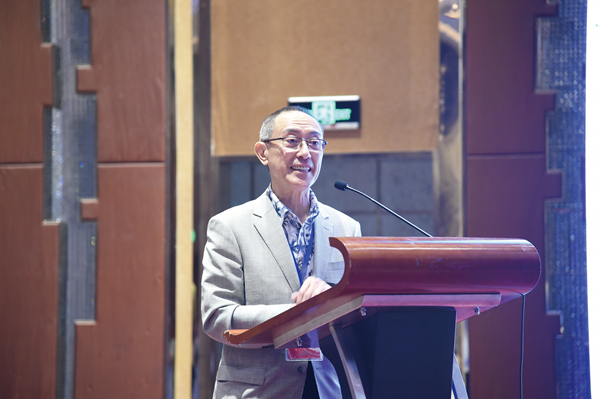
MAO Junhui (Art Supervisor of Asian Performing Arts Studio in HK)
While providing art space for Chinese traditional opera performance, shall today’s playwrights give a second thought of the core values of their creation? Do their stories have any connection with or contrast against the contemporary living experience? Do their ways of narration or choreography bring the audiences into a natural and reasonable plot like their vivid life? Art form seldom hinders our introduction of Chinese traditional operas to overseas audiences so long as the plot is blessed with significant thoughts, interesting tastes and touching points. However, those so-called 'new creation', in absence of reality, of void contents and boring novelty will invariably be refused by audiences worldwide anywhere.
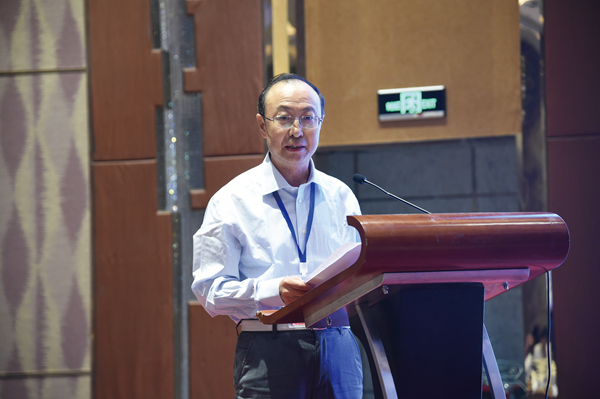
SONG Shenggui (Vice President of Art College of Inner Mongolia University)
In the current economic and cultural background, it is necessary and important to make integration and adjustment on arts of minority nationalities, including aesthetic cultural resources. Particularly, it is a must to find and revitalize the key point, and opportunities to develop various arts of minority nationalities, and achieve a new growing point in culture, to which the contemporary art criticism shall make its own contribution. For example, on the basis of mastery of art resources of minority nationalities, art critics shall consciously provide an analysis on how to fulfill the survival and development in the current context, and enable readers to understand the aesthetic values of minority nationalities by advocating and establishing harmony of varied cultures and arts.
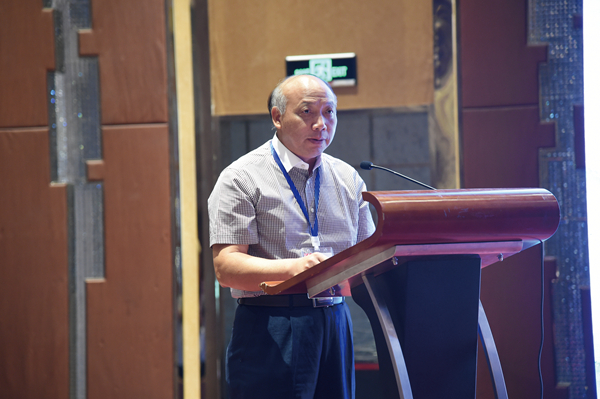
JIANG Shuzhuo (President of Guangdong Writers Association)
As a spiritual foundation of national stability, cultural traditions must be creatively transformed with the contemporary values, which is indispensible with the critical practice in contemporary literature and arts. On the one hand, stress on the connection and integration of cultural traditions with the current society is considered to be confirmation and innovation of the traditional merit, of Chinese culture as well as a significant purpose to promote cultural tradition in the current society as well as the cultural rejuvenation of Chinese nation. On the other hand, as a kind of spiritual and thinking resource, cultural tradition, shall survive the time passage and become a key source for contemporary ideological and cultural construction, and then exert a positive impact upon the native constructions of contemporary theory on literature and arts. Of course, this process must be realized in the dialogues and interaction between cultural traditions and contemporary literary and art criticism.
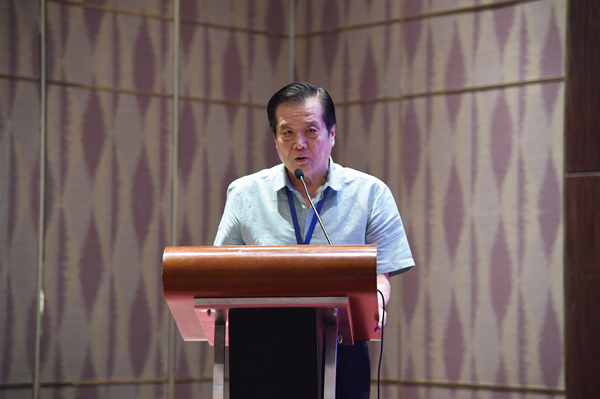
WANG Weijiang (President of Chinese Broadcast and TV Production Guild in Taiwan)
In retrospect of the past 15 years of film and TV exchange across the Straits, five periods can be obviously seen. Period One (1988-1999) was the prime time for introduction, co-production and production assistance across the Straits. Period Two started from the year 2000 when State Administration of Film, Radio and Television stipulated a strict restriction on introduction and co-production. Period Three starts from January 1, 2008 when the co-production of TV dramas were allowed to be on show at daily prime time as those local productions. Period Four started from November 30, 2011 when four new measures of “Further Promotion in Radio, Film and TV Cooperation and Exchange across the Straits” were issued. In Period Five, due to lack of competitiveness and for challenges of new media, Taiwan TV dramas had to give up the conventional TV market of Mainland.
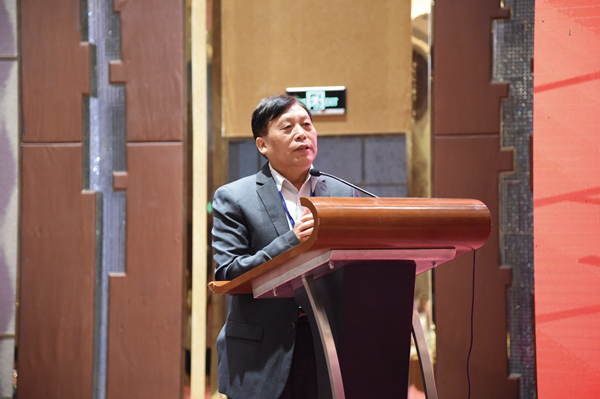
ZHU Shoutong (Dean of Chinese Language Department of Macao University)
Our literary and art critical essay is blessed with a cultural compatibility. Between varied arts and writing styles, there are differences and connections, and measures for evaluation vary as well. Thus, we need to readjust the logic of literary and art criticism. The mere academic research atmosphere will probably neglect the critic’s subjective feelings and make the essay too boring to read. Critics should provide an individual interpretations about society and civilization in literature and arts, with poetic interess and humanist attration. Only those critical essays of compatible aesthetics can surpass the stereotyped academic thesis and enrich the contents of literary and art criticism.
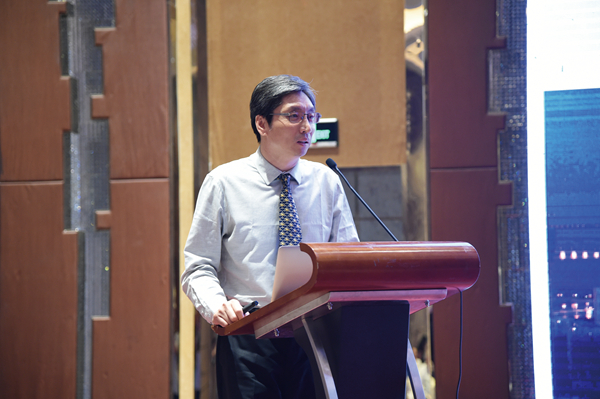
ZHANG Zhiqing (Head of Humanity and Arts College of Macao University of Science and Technology)
Before inheriting culture and establishing national image, we must face two tendencies. Firstly, with the revival of China, China’s national image has received an increasing attention both at home and abroad. Secondly, the process of globalization, especially in the Internet age, is gaining more power in economy, politics and culture. The cultural globalization has caused identical presentation in varied cultures. Currently, culture is no longer a physical concept and needs to be examined in the mixed and dynamic context. We must stress that cultural inheritance is the very prerequisite for establishing national image. Fully aware of cultural and historic power, we must rely on academic research, massive participation and youth passion to realize the contemporary interpretation of cultural tradition in the carrier of new media.

WANG Yonghao (President of Shanghai Literary and Art Critics Association)
In any literary and art criticism, the critic’s cultural position must be obvious. Without original patent and coherent system construction, the mere imitation of Western theories and arguments will find no way to develop China’s contemporary literary and art criticism. On the contrary, any critic’s ideal must be adhered to so as to integrate his or her own theory into the tradition and then achieve a further expansion and development. Particularly, it is extremely important to highlight our “Chinese-style” criticism on literature and arts. “Chinese-style” means that all critical essays must be written in the Chinese language and in accordance with mandarin logic and grammar. Moreover, the traditional aesthetics, tastes and elegance should be restored in the ways of expression and composition.
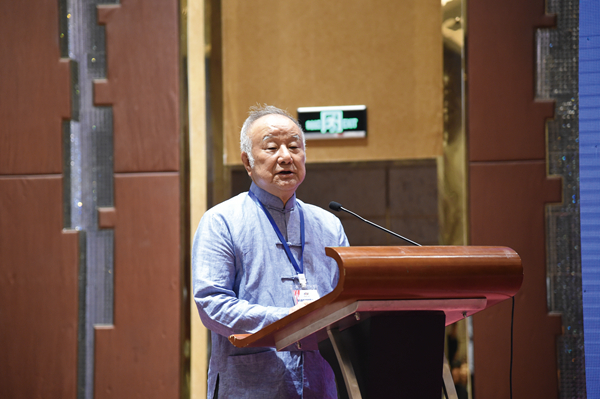
LIU Guosong (Guest Professor of Taiwan Normal University)
There are two divisions in the world painting. The oriental division is characterized by water and ink while the occidental division is featured by oil painting. Despite many differences in adopted materials, techniques and ways of presentation between the two divisions, artists’ spiritual pursuit becomes the common ground of mankind. As for painting forms, realistic expression evolves into freehand and even abstract conception, which showcases the different developments of the two divisions. We were once blessed with a great tradition in painting, and we need to ponder over the reason why we are now left behind. While our western peers make full use of Chinese elements in arts, why can’t we revive our own tradition in the current canvas? We should never underestimate our values as any painter, just like a scientist, is the creator of human civilization history, and his or her studio is just like a lab for scientists new experiments. What a painter needs to consider how to present new ideas and skills in their aitistic.
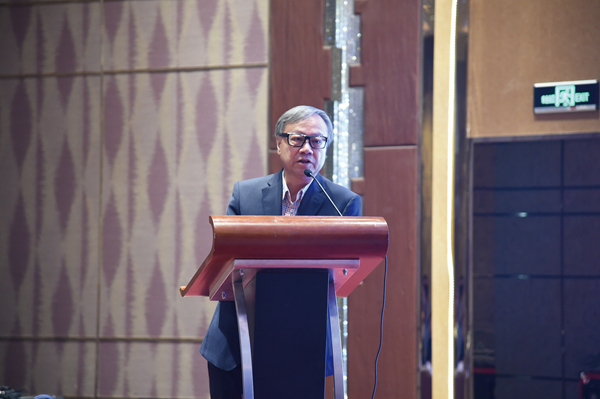
YANG Chuntang (Director of Sun Museum in HK)
Museum education was introduced to Shanghai in the latter half of the 19th century and so far has been commonly recognized as a cultural venue for social education and lifetime learning. Certainly, the educational scope of a museum shall never be limited within relics and artifacts. Our museum should shoulder solemn responsibility to preserve and promote Chinese culture. In a macroscopic definition, Chinese culture involves ancient times and the current age, tradition and modernity, history, arts, science and exchanges between China and the world. Museums should endeavor for genuine exhibits, provide captions and discover the cultural background for each exhibit. Government and nongovernmental organizations should commonly participate in museum education in their own way. In a proper manner, any museum, regardless of its size, can make its own contribution to the development of Chinese culture.

ZHANG Zexun (Associate Professor, Faculty of Education, Macao University)
Chinese painted sculpture has left us numerous world cultural heritages, but due to its apparent regional locality, it is exceedingly hard for us to find a clue concerning specific influence from outside world. However, in the historical context, a comparative study of its figure, image, theme and contents will enlighten us on how Chinese painted sculpture absorbed foreign cultures through exchanges along the ancient Silk Road to attain development. In the meanwhile, the Silk Road enabled Chinese culture and arts to reach the West and exert a significant influence. For example, the discussion on Qiuci Grotto Art in Xinjiang demonstrates the relationship of this art with the cultures of India, Greece and Iran, as well as the impact of culture and arts from Central China that was spread to the West through the Silk Road.

JIN Hao (Professor of Beijing Dance Academy)
When mentioning the contemporary aesthetic appreciation of Chinese classical dance, I think that the following five points must be taken into consideration: dancer’s figure charm in highlighting role’s feature, aesthetic law of “Figure, Charm, Momentum and Rhythm”, variation of traditional rhythm, freehand spiritual vision in pure dance, and respectful integration of historical and cultural resources. As everyone gains a different understanding and knowledge of the spirit of Chinese classical dance, dance means aspiration for transcendence over the brilliance of arts as well as domination of vitality while dancing through the whole life. With their bodies always available for dance, people naturally show new aesthetic expectation towards the traditional Chinese dance art.
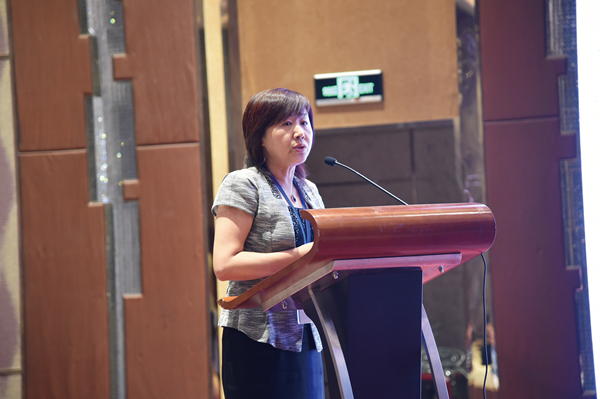
YU Wenxiu (Vice President of Heilongjiang Federation of Literary and Art Circles)
One of the most outstanding features of culture is the blurred limitation of different domains in our times, which has caused similar blurred phenomenon and theory. It is increasingly hard to tell original ideas from imitation or literature from entertainment. Particularly when media becomes the powerful ceuter, it interferes with the structure, rule and tendency of literature more and more frequently. In this circumstance, the criterion and aesthetics of literature become identical with that of entertainment. Priority of youth and sex attractions has become the cultural capital as well as trump card of massive women writers who were born in the 1970s and 1980s. However, instead of being kidnapped by this material age, those women writers wsll harvest their experience and thinking with the adracement of their sge and achieve a profound transcendence.
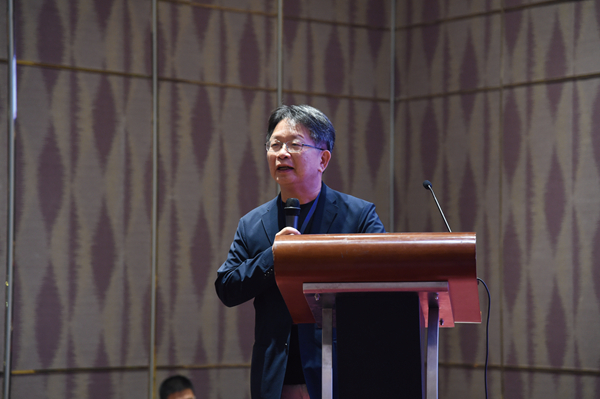
ZHONG Mingde (Professor, Theatre Department of Taipei University of the Arts)
The trans-cultural attraction of Tao Dance Theatre lies in the “living bodies” of dancers because the audiences have been carried away by such primitive and unusual power before they comprehend the message conveyed by dancers’ body language. TAO Ye, the founder of Tao Dance Theatre, always stresses upon “repetition”, “extreme”, “boredom” and “faith”. By means of “repetition”, he intends to reduce the daily mechanism, to revitalize the body’s energy and to realize the “organic status”—a body condition of high sensitivity and full energy, which was mentioned by such two masters as Stanislavski and Grotowski. Such elaborations by Stanislavski, Grotowski and Barba have pointed out a straight passage to the essence of arts for all avant-garde artists, including TAO Ye.
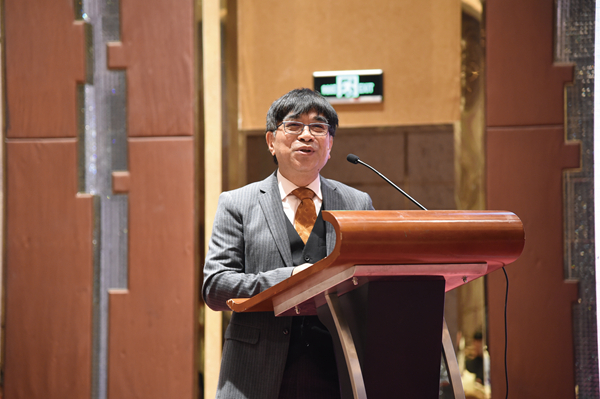
LU Weili (Member and Chair of Artistic Critics of Hong Kong Arts Development Council)
In Chinese culture, “body”, “phenomenon” and “function” are three inter-related dimensions of everything in the world, within which “vision” in its further is the medium of “body” and “function”. As a universal concept available in the East and the West, “vision” analysis may ease the differences between critical traditions of the East and the West. In China, meaning, expression and vision are three aspects of a concept. Despite blurred definitions, those three have a less complicated relationship. Readers or listeners will receive expression first, and then vision and finally meaning, which is witnessed in an old Chinese saying “meaning over vision and vision over expression”. In a word, in a cultural atmosphere of integration between the East and the West and in the dialectical course of tradition and modernity, there will be far more possibilities in China’s contemporary theatre, and therefore Chinese scholars’ theatre analysis will witness a higher development.
